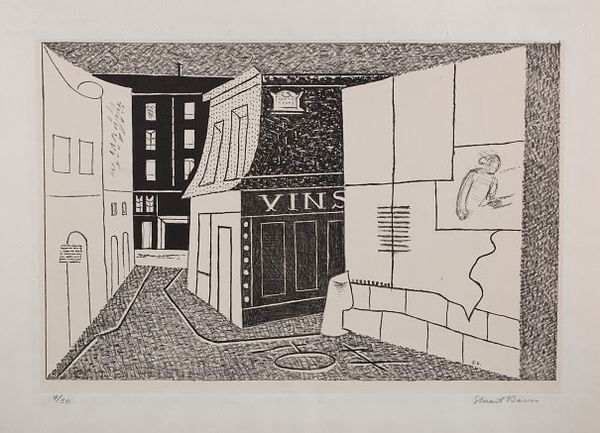Stuart Davis, Rue des Rats, 1928-29. Estimate $6,000 - 8,000. Editions Modern. Davis © 2020 Estate of Stuart Davis / Licensed by VAGA at Artists Rights Society (ARS), NY.
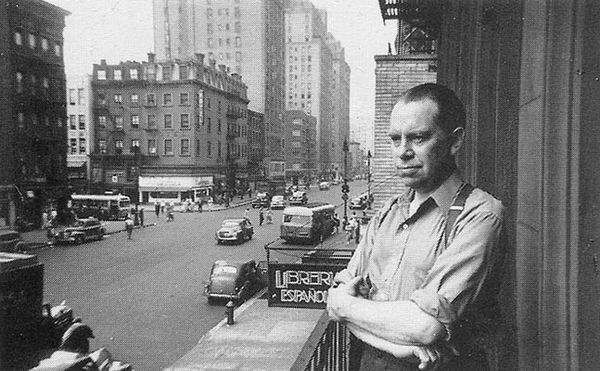
Stuart Davis outside his studio at 43 Seventh Avenue, New York, 1935. Photography by Earl Davis. Davis © 2020 Estate of Stuart Davis / Licensed by VAGA at Artists Rights Society (ARS), NY.
Stuart Davis was an artist fiercely, undeniably devoted to the ethos of modernism. Born in Philadelphia in 1892, he grew up around art; his father was the art editor of the Philadelphia Press, his mother was a sculptor. This supportive environment propelled Davis to New York where he studied under Robert Henri at the New York School of Art. Henri’s students were trained to work in realism, to look for inspiration in their daily lives, which fostered Davis’ sensitivity to his surroundings.
By 1913, Davis had five watercolors on view at the Armory Show in New York. The 1913 Armory Show introduced American audiences to the work of the European modernists, many for the first time. Davis was in such awe of what he saw that he vowed to commit himself to the teachings of modernism. “I sensed an order in these works which I felt was lacking in my own,” he later wrote. “I resolved that I would quite definitely have to become a ‘modern’ artist.” Going forward, Davis’ artistic focus was diverted from realism as he sought to create works that better reflected the realities of a modern industrial society.
Paris
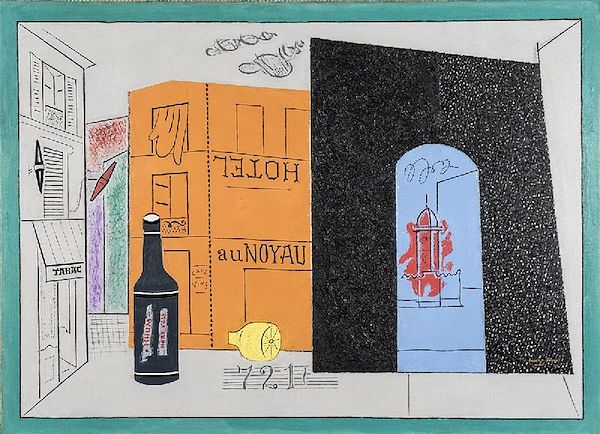
Stuart Davis, Arch Hotel, 1929, Oil on canvas, Sheldon Memorial Art Gallery, University of Nebraska-Lincoln, F.M. Hall Collection. Davis © 2020 Estate of Stuart Davis / Licensed by VAGA at Artists Rights Society (ARS), NY.
In the early 1900s, Paris was the epicenter of modernism and a rapidly evolving hub for artists. To immerse himself in the movement, Davis rented a studio in 1928 and spent 13 months in Paris. Davis’ time there proved fundamental in the progression of his practice, as he aimed to accommodate both nature and abstraction. It was also the first time Davis seriously engaged with printmaking.
Scholars believe that the Paris prints were produced with the guidance and expertise of the highly sought-after Master Printer, Edmond Desjobert. While the records on Davis and Desjobert’s printing relationship are incomplete, Desjobert’s atelier likely introduced Davis to lithography, which allowed Davis to revisit subjects and compositions from his paintings in a new formal way. “These [Paris] prints demonstrate an uncommon sensitivity to the compositional function of paper that is the mark of a sophisticated understanding of the aesthetic and formal properties of the medium,” stated Diane Kelder, Art Historian and Stuart Davis scholar in her 1986 essay “Stuart Davis: Methodology and Imagery.”
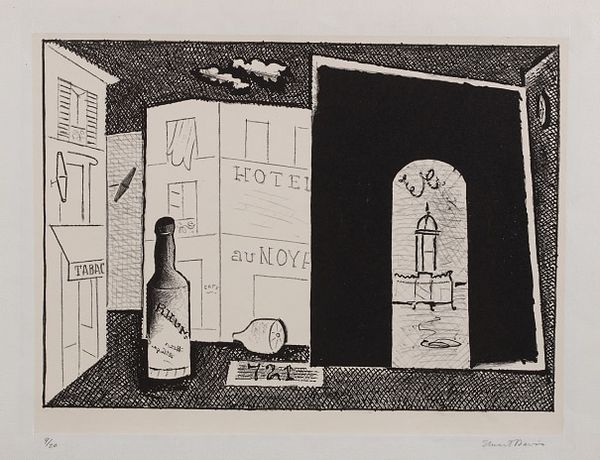
Stuart Davis, Arch No. 2, 1929. Estimate $4,000 - 6,000. Editions New York. Davis © 2020 Estate of Stuart Davis / Licensed by VAGA at Artists Rights Society (ARS), NY.
There is an apparent evolution in Davis’ prints. Some prints portray the winding streets of Paris on a single plane, while others present more straightforward depictions of his surroundings. “Although Davis’s Paris prints do not lend themselves to a strict chronology,” wrote Diane Kelder, “it may be that such lithographs as Arch No. I and Arch No. 2 characterized by more complex imagery, fall later in the series than the more direct interpretations of Parisian street scenes.” Arch No. I (Lot 2) and Arch No. 2 (Lot 3) allow the eye to wonder through pattern and contrast. Davis masterfully uses lithography to flatten storefronts and imbue form through the high contrast of black ink on white paper.
Similarly, the interpretations of the Place Pasdeloup, located in the 11th arrondissement, play with the amount of linear information necessary for the scene to be recognizable. Place Pasdeloup No. I (Lot 5) and Place Pasdeloup No. 2 (lot Lot 6) further support this exercise in abstraction, as Davis presents the building’s architectural details as more open, abstracted patterns.
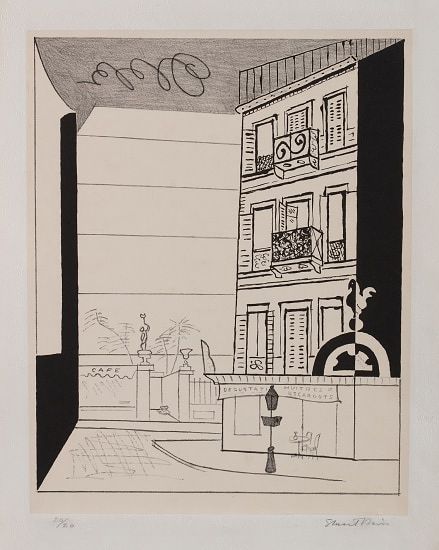
Stuart Davis, Place Pasdeloup No. 2, 1929. Estimate $4,000 - 6,000. Editions Modern. Davis © 2020 Estate of Stuart Davis / Licensed by VAGA at Artists Rights Society (ARS), NY.
An example of a more direct interpretation of the Paris streets, can been seen in Rue des Rats (Lot 1). This lithograph was selected by the artist John Sloan to be included in the American Institute of Graphic Arts’ fifth annual Fifty Prints of the Year exhibition, an important show for modern printmaking. “In the lithograph Rue des Rats, [Davis] used crayon to convey the light-stippled areas of the roof and introduced dense woven patterns in the sky and street, which create an effect comparable to the crust, sand-permeated pigment [of the painting, Rue des Rats No. 2]” wrote Diane Kelder. Again, we see Davis experimenting with the possibilities of lithography, as he translates his paintings into a new medium.
New York
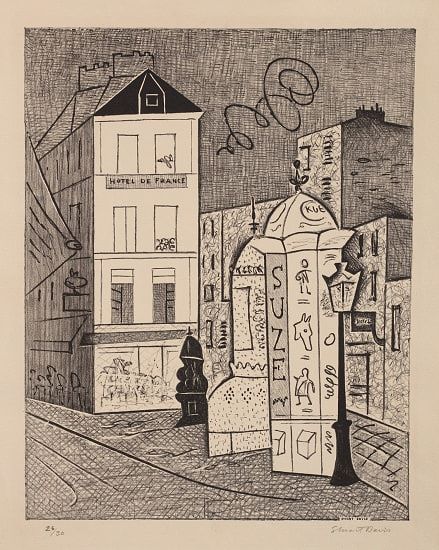
Stuart Davis, Hotel de France, 1929. Estimate $4,000 - 6,000. Editions New York. Davis © 2020 Estate of Stuart Davis / Licensed by VAGA at Artists Rights Society (ARS), NY.
In 1931, after his return to New York, Davis painted New York-Paris No. 2, merging Paris and New York and placing us in both cities at once. The painting, which features key elements from the lithograph Hotel de France of 1929, merges a New York train platform with iconic Parisian architecture. Davis’ Paris prints present a divergence from realism, abstracting architecture to create new forms—and beginning an exploration he would pursue for the rest of his career.
Unlike the Paris prints, Davis’ New York prints are largely independent of paintings. It is probable that the lithographs Davis made in New York were printed with George C. Miller, although a lack of documentation makes it difficult to be certain. These lithographs Davis made in the New York present the artist’s talent for creating robust patterns and graphic abstractions. Composition (Lot 7) from 1931, combines figural elements (an arm) with an emphasis on pattern, which in their “virtual abstraction,” as Diane Kelder wrote, "prefigure[s] many of Davis’s later painterly concerns.”
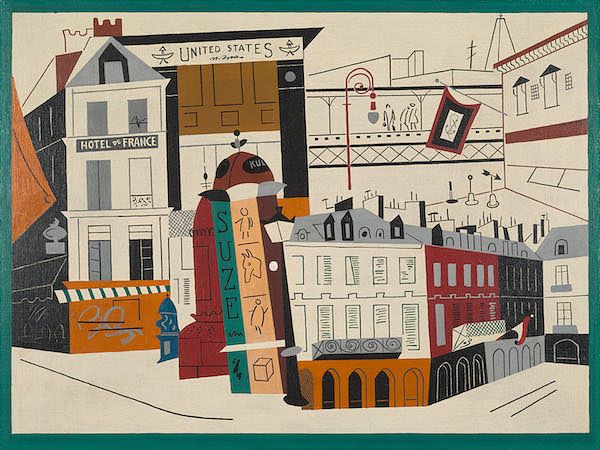
Stuart Davis, New York-Paris No. 2, February 1931, Oil on canvas, Portland Museum of Art, Portland, Maine; Hamilton Easter Field Art FoundaEon Collection; Gift of Barn Gallery Associates, Inc., Ogunquit, Maine, 1979. Davis © 2020 Estate of Stuart Davis / Licensed by VAGA at Artists Rights Society (ARS), NY.
Davis’s lithograph, Anchor (Lot 8) was published in a portfolio to benefit the American Artist School in New York. The scene is nautical, hence its title, and combines hints of rural architecture with boats. When looking at the form in its entirety, the bow of a ship appears, slightly more visible to the eye in Davis’s initial graphite study. Anchor is the result of his ongoing experimentation with—and confidence in—these pattern-like abstractions.
Stuart Davis’ initial investigation into lithography in Paris and continued exploration in New York represent the active migration of modernism from Europe to New York, of which Stuart Davis was a central figure. This rare collection of Davis’ prints present an exceptional insight into the progression of his work as he devoted himself to becoming a “modern” artist. Assembled in the 1960s and 70s from a passionate Midwest collector, this collection was mainly acquired from dealer Sylvan Cole at the famed Associated American Artists gallery in New York. A few of the images have not appeared at auction in over 30 years.
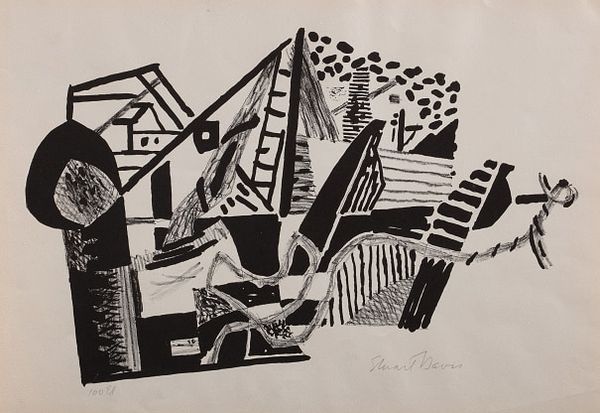
Stuart Davis, Anchor, 1936. Estimate $3,000 - 5,000. Editions Modern. Davis © 2020 Estate of Stuart Davis / Licensed by VAGA at Artists Rights Society (ARS), NY.
Discover More from Editions Modern >

Recommended Reading
Author Picks: Editions & Works on Paper >
Emerging Talent: 12 Artists to Watch >
